Table Of ContentThis page intentionally left blank
Light and Photosynthesisin Aquatic Ecosystems
Third edition
Beginningsystematicallywiththefundamentals,thefullyupdatedthirdeditionof
thispopulargraduatetextbookprovidesanunderstandingofalltheessential
elementsofmarineoptics.Itexplainsthekeyroleoflightasamajorfactorin
determiningtheoperationandbiologicalcompositionofaquaticecosystems,and
itsscoperangesfromthephysicsoflighttransmissionwithinwater,throughthe
biochemistryandphysiologyofaquaticphotosynthesis,totheecological
relationshipsthatdependontheunderwaterlightclimate.Thisbookalsoprovides
avaluableintroductiontotheremotesensingoftheoceanfromspace,whichis
nowrecognizedtobeofgreatenvironmentalsignificanceduetoitsdirect
relevancetoglobalwarming.
Animportantresourceforgraduatecoursesonmarineoptics,aquatic
photosynthesis,oroceanremotesensing;andforaquaticscientists,both
oceanographersandlimnologists.
john t.o. kirk beganhisresearchintooceanopticsintheearly1970sinthe
DivisionofPlantIndustryoftheCommonwealthScientific&IndustrialResearch
Organization(CSIRO),Canberra,Australia,wherehewasachiefresearch
scientist,andcontinueditfrom1997inKirkMarineOptics.Hewasawardedthe
AustralianSocietyforLimnologyMedal(1981),andbesidesthetwosuccessful
previouseditionsofthisbook,hasalsoco-authoredThePlastids:TheirChemistry,
Structure,GrowthandInheritance(Elsevier,1978),whichbecamethestandardtext
initsfield.
Beyondhisownscientificresearchinterests,hehasalwaysbeeninterestedinthe
broaderimplicationsofscienceforhumanexistence,andhaspublishedabookon
thisandotherissues,ScienceandCertainty(CSIROPublishing,2007).
Light and Photosynthesis
in Aquatic Ecosystems
Third edition
JOHN T. O. KIRK
Kirk Marine Optics
CAMBRIDGEUNIVERSITYPRESS
Cambridge,NewYork,Melbourne,Madrid,CapeTown,Singapore,
Sa˜oPaulo,Delhi,Dubai,Tokyo,MexicoCity
CambridgeUniversityPress
TheEdinburghBuilding,CambridgeCB28RU,UK
PublishedintheUnitedStatesofAmericabyCambridgeUniversityPress,NewYork
www.cambridge.org
Informationonthistitle:www.cambridge.org/9780521151757
#JohnT.O.Kirk2011
Thispublicationisincopyright.Subjecttostatutoryexception
andtotheprovisionsofrelevantcollectivelicensingagreements,
noreproductionofanypartmaytakeplacewithout
thewrittenpermissionofCambridgeUniversityPress.
Firstpublished1983
Secondedition1994
PrintedintheUnitedKingdomattheUniversityPress,Cambridge
AcataloguerecordforthispublicationisavailablefromtheBritishLibrary
LibraryofCongressCataloging-in-PublicationData
Kirk,JohnT.O.(JohnThomasOsmond),1935–
Lightandphotosynthesisinaquaticecosystems/JohnT.O.Kirk.–3rded.
p.cm.
Includesbibliographicalreferencesandindexes.
ISBN978-0-521-15175-7(Hardback)
1. Photosynthesis. 2. Plants–Effectofunderwaterlighton. 3. Aquaticplants–
Ecophysiology. 4. Underwaterlight. I. Title.
QK882.K532010
5720.46–dc22
2010028677
ISBN978-0-521-15175-7Hardback
CambridgeUniversityPresshasnoresponsibilityforthepersistenceor
accuracyofURLsforexternalorthird-partyinternetwebsitesreferredto
inthispublication,anddoesnotguaranteethatanycontentonsuch
websitesis,orwillremain,accurateorappropriate.
Contents
Preface tothe thirdedition page ix
PARTI THEUNDERWATERLIGHTFIELD 1
1 Concepts ofhydrologic optics 3
1.1 Introduction 3
1.2 The nature of light 3
1.3 The properties definingthe radiation field 6
1.4 The inherent opticalproperties 14
1.5 Apparent and quasi-inherent optical
properties 21
1.6 Optical depth 24
1.7 Radiative transfer theory 24
2 Incident solar radiation 28
2.1 Solar radiation outside theatmosphere 28
2.2 Transmission ofsolar radiation through
the Earth’satmosphere 30
2.3 Diurnalvariation ofsolar irradiance 38
2.4 Variation ofsolar irradiance and insolation
with latitude and time of year 42
2.5 Transmission across the air–waterinterface 44
3 Absorption oflight within the aquatic medium 50
3.1 The absorption process 50
3.2 The measurement of light absorption 53
3.3 The major light-absorbing components
of theaquatic system 61
v
vi Contents
3.4 Opticalclassification of natural waters 92
3.5 Contributionof the different components
of the aquatic medium toabsorption
of PAR 95
4 Scattering oflight within the aquatic medium 98
4.1 The scatteringprocess 98
4.2 Measurementof scattering 104
4.3 The scatteringproperties ofnatural waters 116
4.4 The scatteringproperties ofphytoplankton 128
5 Characterizing theunderwater lightfield 133
5.1 Irradiance 133
5.2 Scalar irradiance 143
5.3 Spectral distribution ofirradiance 144
5.4 Radiance distribution 147
5.5 Modelling the underwater light field 149
6 The nature ofthe underwater lightfield 153
6.1 Downward irradiance – monochromatic 153
6.2 Spectral distribution ofdownward irradiance 159
6.3 Downward irradiance – PAR 159
6.4 Upward irradiance and radiance 168
6.5 Scalar irradiance 178
6.6 Angular distribution ofthe underwater
light field 181
6.7 Dependence ofproperties ofthe field
on optical properties of themedium 188
6.8 Partialverticalattenuation coefficients 197
7 Remotesensing ofthe aquatic environment 199
7.1 The upward flux and its measurement 200
7.2 The emergentflux 215
7.3 Correction foratmospheric scattering
and solar elevation 218
7.4 Relationbetween remotelysensed reflectance
and thescattering/absorption ratio 225
7.5 Relationbetween remotelysensed reflectances
and water composition 228
Contents vii
PART II PHOTOSYNTHESIS INTHE AQUATIC
ENVIRONMENT 263
8 The photosynthetic apparatus of aquatic plants 265
8.1 Chloroplasts 265
8.2 Membranes and particles 268
8.3 Photosynthetic pigmentcomposition 275
8.4 Reaction centresand energy transfer 298
8.5 The overallphotosynthetic process 300
9 Light captureby aquaticplants 308
9.1 Absorption spectra ofphotosyntheticsystems 308
9.2 The packageeffect 311
9.3 Effects ofvariation incell/colony size and shape 314
9.4 Rate oflight absorptionby aquatic plants 319
9.5 Effect of aquatic plants on theunderwater light field 325
10 Photosynthesisas a function ofthe incident light 330
10.1 Measurement ofphotosynthetic rate in aquatic
ecosystems 330
10.2 Photosynthesis and light intensity 339
10.3 Efficiency of utilization of incident light energy 360
10.4 Photosynthesis and wavelength of incident light 380
11 Photosynthesisin theaquaticenvironment 388
11.1 Circulation anddepth 388
11.2 Optical characteristics ofthe water 397
11.3 Other limitingfactors 400
11.4 Temporal variation inphotosynthesis 430
11.5 Photosynthetic yield per unit area 440
12 Ecological strategies 453
12.1 Aquaticplant distributionin relation to light quality 453
12.2 Ontogenetic adaptation –intensity 469
12.3 Ontogenetic adaptation –spectral quality 479
12.4 Ontogenetic adaptation –depth 488
12.5 Significance of ontogeneticadaptation of the
photosynthetic system 503
12.6 Rapid adaptation of thephotosynthetic system 514
viii Contents
12.7 The microphytobenthos 528
12.8 Highly productive aquatic ecosystems 532
References and author index 539
Index tosymbols 626
Index toorganisms 628
Index towater bodies 632
Subject index 638
The colour plates appear betweenpages212 and 213.
Description:Beginning systematically with the fundamentals, the fully-updated third edition of this popular graduate textbook provides an understanding of all the essential elements of marine optics. It explains the key role of light as a major factor in determining the operation and biological composition of a

